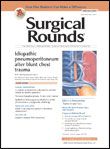Publication
Article
Prophylaxis Protocols Improve Post-op Venous Thromboembolism Outcomes
Author(s):
By emphasizing early postoperative mobilization alongside mandatory venous thromboembolism (VTE) risk stratification and concurrent electronic prophylaxis recommendations, hospitals can significantly reduce the likelihood of VTE complications among surgical patients.

What does a medical institution do when National Surgical Quality Improvement Program (NSQIP) data reveals it is an outlier on a performance measure? Ideally, it analyzes the data internally, finds the root causes for the deficiencies, and implements interventions to reduce unacceptable outcomes.
Boston Medical Center (BMC) took those steps when NSQIP data identified it as a high outlier for postoperative venous thromboembolism (VTE), a potentially life-threatening complication that can be difficult to address. Although the NSQIP reported that the odds of a patient experiencing a VTE after a general or vascular surgery procedure at BMC was 3.4 times greater than expected in 2010, the hospital implemented a successful quality improvement process soon after, which was described in the June 2014 issue of the Journal of the American College of Surgeons.
In 2011, BMC adopted an electronic physician orders (EPO) system to execute a strategy to decrease VTE complications using the Caprini grading system, which mandates a type and duration of VTE prophylaxis. In addition to calculating the Caprini score, the EPO prompted physicians to employ early postoperative mobilization and mandatory VTE risk stratification for every patient, and it also sent automatic preoperative, postoperative, and discharge electronic reminders about appropriate VTE prophylaxis.
After comparing NSQIP VTE outcomes before and after implementing the standardized risk-stratified protocol combined with a postoperative mobilization program, BMC staff found the incidence of deep venous thrombosis (DVT) decreased by 84%, while the incidence of pulmonary embolism (PE) was halved. Additionally, risk-adjusted VTE outcomes steadily declined from an odds ratio of 3.41 to 0.94.
By emphasizing early postoperative mobilization alongside mandatory VTE risk stratification and concurrent electronic prophylaxis recommendations, BMC significantly reduced the likelihood of VTE complications among its surgical patients. Among the hospital’s surgeons, compliance with program recommendations was high, especially since the program allowed them to note why they chose not to follow the recommendations, which removed some of the “cookbook medicine” feel of most automated systems.






